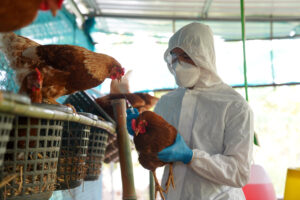The main focus of this week’s newsletter is how FDA is partnering with the states for enforcement of the Produce Safety Rule. But before we get to that I want to alert those reading our newsletter that I have seen my first 483 for lack of compliance with FSVP. So, if you are under the FSVP rule be aware that FDA is holding facilities accountable for compliance and issuing 483s when importers are not compliant. Turning to the Produce Rule, I often get asked whether FDA has the resources to be able to enforce FSMA, and my answer is that while FDA clearly lacks resources, it has enough inspectional resources to make life very unhappy for those that are not compliant with FSMA requirements. A case in point is that the Produce Rule is not only the first federal food safety rule established for produce farms, its implementation and oversight is outside the standard food-facility inspection expertise of FDA. Further, the agency does not have the resources to be able to get on farms, but the states are often already on farms. Because of this, FDA has long held that a partnership with the states is necessary to help food producers and growers understand and achieve the new requirements, primarily because the states have a long history of successfully working with their farming communities. During the second half of 2017, FDA turned some specific focus toward this implementation, emphasizing the importance of the collaboration and communication in overcoming challenges; awarding funding to states for implementation; and meeting with the National Association of State Departments of Agriculture (NASDA) to discuss and address concerns. Addressing Concerns. In late November, FDA Commissioner Scott Gottlieb published an open letter to the state agriculture departments, in which he reinforced the agency’s commitment to partner with the states to implement FSMA and provided a summary of key topics discussed at a November meeting with NASDA representatives. To address the concerns expressed by NASDA at the meeting related to the food safety regulatory issues and challenges being faced at the state level, FDA is focusing on: Packing house/terminal markets. Working to clarify whether a packing house or terminal market is required to comply with the preventive controls or produce rules. Because the solution may require rulemaking – for which efforts are underway, FDA plans to exercise enforcement discretion for certain packing, packaging, and/or holding facilities, and make the policy public by January 2018. Dispute resolution for the produce rule. FDA is exploring an inspection documentation and review process tailored to produce inspections that enhances fairness and consistency in FDA and state inspections. The agency expects to be able to provide greater detail for NASDA in early 2018. Policy for On-Farm Readiness Review (OFRR) visits. FDA and NASDA have agreed on an approach, and a revised draft will be discussed next month. Over the next year, if a state or FDA OFRR shows certain serious conditions or practices, but the farm makes immediate corrections to the reviewers’ satisfaction and no affected produce has or will enter commerce, then reviewers need not alert FDA/refer the farm for inspection. However, if produce has already entered commerce, the observation needs to be documented and/or reported, as a recall or other action may be triggered. The approach is being clearly communicated to all FDA staff involved in OFRR implementation. Agricultural water. FDA and NASDA staff will discuss agricultural water quality and testing at an upcoming summit, with NASDA and other key stakeholders partnering in the discussions. The produce safety team at FDA’s Center for Food Safety and Applied Nutrition (CFSAN) also will work to develop a more comprehensive plan and timeline for the consideration of agricultural water standards. Training. FDA is planning to host NASDA for a multi-day workshop on training needs for state regulators and extension staff before the end of 2017. The goal will be to finalize the number of regulators and extension staff who must be trained, determine the exact training needed, and ensure that adequate training is planned and scheduled. State Funding. To further leverage the critical relationships with the states in achieving the goals of FSMA for fresh fruits and vegetables, FDA awarded $30.9 million in funding earlier this year to support 43 states in their continued efforts to help implement the produce safety rule. At nearly one-and-a-half times the $21.8 million awarded in 2016, it is the largest allocation of funds to date. The availability of funding to states to support the produce safety rule was first announced in March 2016, with bids open to all states and U.S. territories. Its goal is to ensure that awardees have the resources to formulate a multi-year plan to implement a produce safety system and develop and provide education, outreach and technical assistance. These programs which are to address the specific and unique needs of each farming community will prioritize the operations covered by the produce safety rule. Additionally, FDA intends to continue outreach to the states, with a goal of hearing from farmers and other food producers to understand challenges that remain and how FDA can best support their efforts to enhance produce safety. About The Acheson Group (TAG) Led by Former FDA Associate Commissioner for Foods Dr. David Acheson, TAG is a food safety consulting group that provides guidance and expertise worldwide for companies throughout the food supply chain. With in-depth industry knowledge combined with real-world experience, TAG’s team of food safety experts help companies more effectively mitigate risk, improve operational efficiencies, and ensure regulatory and standards compliance. www.AchesonGroup.com






